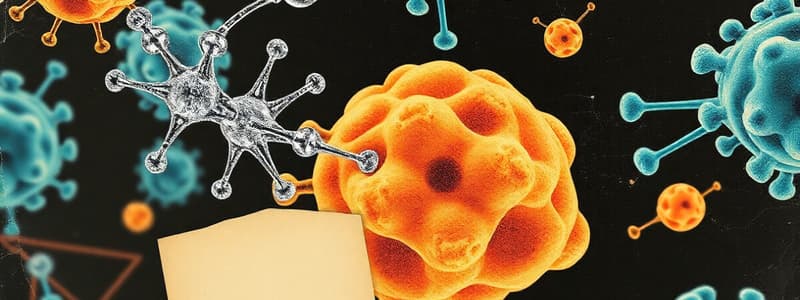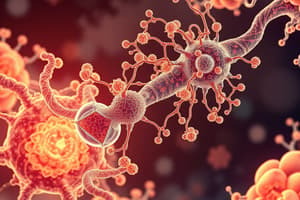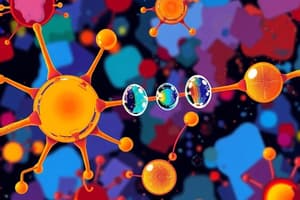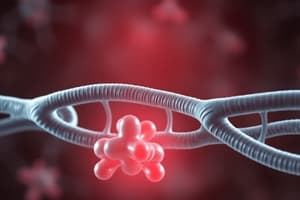Podcast
Questions and Answers
What is the role of a ligand in receptor interactions?
What is the role of a ligand in receptor interactions?
- It causes the receptor to degrade.
- It triggers immediate apoptosis in the cell.
- It enhances the receptor's ability to form complexes.
- It binds to a receptor to initiate a cellular response. (correct)
Which term describes a measure of how well a molecule fits a receptor?
Which term describes a measure of how well a molecule fits a receptor?
- Conformational change.
- Binding affinity. (correct)
- Efficacy.
- Dissociation constant.
Which of the following is a characteristic of full agonists?
Which of the following is a characteristic of full agonists?
- They produce the maximal biological response. (correct)
- They inhibit receptor activity completely.
- They cause partial activation of receptors.
- They exhibit constitutive activity.
What happens when an antagonist binds to a receptor?
What happens when an antagonist binds to a receptor?
How is the final biological response, such as muscle contraction, achieved?
How is the final biological response, such as muscle contraction, achieved?
What is constitutive activity in a receptor?
What is constitutive activity in a receptor?
Which factor is associated with a drug's ability to bind to a receptor and form a D-R complex?
Which factor is associated with a drug's ability to bind to a receptor and form a D-R complex?
What distinguishes inverse agonists from other ligands?
What distinguishes inverse agonists from other ligands?
Which receptor type is classified as a transmembrane protein?
Which receptor type is classified as a transmembrane protein?
What does potency refer to in relation to the efficacy of a receptor?
What does potency refer to in relation to the efficacy of a receptor?
How does the efficacy of Efficacy X and Efficacy Z compare?
How does the efficacy of Efficacy X and Efficacy Z compare?
Which of the following statements about peripheral membrane proteins is true?
Which of the following statements about peripheral membrane proteins is true?
If Potency X is greater than Potency Y, what can be inferred about the EC50 values?
If Potency X is greater than Potency Y, what can be inferred about the EC50 values?
Which of the following receptors is an example of an ionotropic receptor?
Which of the following receptors is an example of an ionotropic receptor?
In terms of receptor classification, G protein-coupled receptors belong to which category?
In terms of receptor classification, G protein-coupled receptors belong to which category?
What does it mean if Efficacy X equals Efficacy Y?
What does it mean if Efficacy X equals Efficacy Y?
What role do receptor tyrosine kinases play in cells?
What role do receptor tyrosine kinases play in cells?
What is the sequence of events following ligand binding to receptor tyrosine kinases?
What is the sequence of events following ligand binding to receptor tyrosine kinases?
Which type of receptors are characterized as ligand-gated ion channels?
Which type of receptors are characterized as ligand-gated ion channels?
Which statement about the STAT proteins is accurate?
Which statement about the STAT proteins is accurate?
What is a common characteristic of metabotropic receptors?
What is a common characteristic of metabotropic receptors?
What type of ligands typically bind to enzyme-coupled receptors?
What type of ligands typically bind to enzyme-coupled receptors?
In electrically excitable cells, what is the role of ligand-gated ion channels?
In electrically excitable cells, what is the role of ligand-gated ion channels?
Which of the following receptors is noted for its involvement with acetylcholine?
Which of the following receptors is noted for its involvement with acetylcholine?
What role do intracellular proteins primarily play in cellular function?
What role do intracellular proteins primarily play in cellular function?
What happens to a class I nuclear receptor upon hormone binding?
What happens to a class I nuclear receptor upon hormone binding?
What initiates the transduction pathway in trans-membrane proteins?
What initiates the transduction pathway in trans-membrane proteins?
How do class II nuclear receptors differ from class I nuclear receptors?
How do class II nuclear receptors differ from class I nuclear receptors?
Which of the following proteins are involved in the action of a class I nuclear receptor when a ligand binds?
Which of the following proteins are involved in the action of a class I nuclear receptor when a ligand binds?
What is a primary function of metabotropic receptors?
What is a primary function of metabotropic receptors?
What type of ligands activate the IP3 receptor on the endoplasmic reticulum?
What type of ligands activate the IP3 receptor on the endoplasmic reticulum?
What is the final result of the nuclear receptor DNA complex recruiting additional proteins?
What is the final result of the nuclear receptor DNA complex recruiting additional proteins?
Which G-protein subtypes stimulate adenylyl cyclase?
Which G-protein subtypes stimulate adenylyl cyclase?
What is the role of GTP in the context of G-protein signaling?
What is the role of GTP in the context of G-protein signaling?
Which of the following represents a second messenger system activated by G-protein signaling?
Which of the following represents a second messenger system activated by G-protein signaling?
Which ion channels are specifically targeted by the G12 subtype of G-proteins?
Which ion channels are specifically targeted by the G12 subtype of G-proteins?
What is the effect of Gi activation in G-protein signaling pathways?
What is the effect of Gi activation in G-protein signaling pathways?
What type of response is elicited by acetylcholine binding to nicotinic receptors?
What type of response is elicited by acetylcholine binding to nicotinic receptors?
In G-protein coupled receptor scenarios, how can one ligand affect multiple signaling pathways?
In G-protein coupled receptor scenarios, how can one ligand affect multiple signaling pathways?
What is one of the primary functions of cAMP in signaling pathways?
What is one of the primary functions of cAMP in signaling pathways?
Which type of receptors are associated with fast neurotransmitters like acetylcholine?
Which type of receptors are associated with fast neurotransmitters like acetylcholine?
What defines the role of phospholipase C in G-protein signaling?
What defines the role of phospholipase C in G-protein signaling?
Which of the following is a characteristic of G-Protein coupled receptors?
Which of the following is a characteristic of G-Protein coupled receptors?
What is the primary role of phospholipases as stimulated by M1 muscarinic receptors?
What is the primary role of phospholipases as stimulated by M1 muscarinic receptors?
In which nervous system division are nicotinic receptors predominantly found?
In which nervous system division are nicotinic receptors predominantly found?
What type of ion channels are opened upon acetylcholine binding to nicotinic receptors?
What type of ion channels are opened upon acetylcholine binding to nicotinic receptors?
Which endogenous ligand is classified as a slow neurotransmitter?
Which endogenous ligand is classified as a slow neurotransmitter?
What type of receptors do steroid hormones typically interact with?
What type of receptors do steroid hormones typically interact with?
Flashcards
Receptor
Receptor
A protein molecule embedded in the plasma membrane or cytoplasm of a cell that binds a signaling molecule to initiate a cellular response.
Ligand
Ligand
A molecule that binds to a receptor, initiating a cellular response. Examples include: neurotransmitters, hormones, and drugs.
Full Agonist
Full Agonist
A ligand that activates a receptor and elicits a full biological response.
Partial Agonist
Partial Agonist
Signup and view all the flashcards
Antagonist
Antagonist
Signup and view all the flashcards
Inverse Agonist
Inverse Agonist
Signup and view all the flashcards
Binding Affinity
Binding Affinity
Signup and view all the flashcards
Efficacy
Efficacy
Signup and view all the flashcards
What is EC50?
What is EC50?
Signup and view all the flashcards
What is Efficacy?
What is Efficacy?
Signup and view all the flashcards
What is binding affinity?
What is binding affinity?
Signup and view all the flashcards
What is Potency?
What is Potency?
Signup and view all the flashcards
What are transmembrane proteins?
What are transmembrane proteins?
Signup and view all the flashcards
What are intracellular proteins?
What are intracellular proteins?
Signup and view all the flashcards
What are peripheral membrane proteins?
What are peripheral membrane proteins?
Signup and view all the flashcards
What are ionotropic receptors?
What are ionotropic receptors?
Signup and view all the flashcards
Intracellular Receptors
Intracellular Receptors
Signup and view all the flashcards
Nuclear Receptors
Nuclear Receptors
Signup and view all the flashcards
IP3 Receptor
IP3 Receptor
Signup and view all the flashcards
Transmembrane Receptors
Transmembrane Receptors
Signup and view all the flashcards
Metabotropic Receptors
Metabotropic Receptors
Signup and view all the flashcards
Hormone Response Element (HRE)
Hormone Response Element (HRE)
Signup and view all the flashcards
Corepressor Protein
Corepressor Protein
Signup and view all the flashcards
Coactivator Protein
Coactivator Protein
Signup and view all the flashcards
What is a receptor?
What is a receptor?
Signup and view all the flashcards
What is a ligand?
What is a ligand?
Signup and view all the flashcards
What are G-proteins?
What are G-proteins?
Signup and view all the flashcards
What is Gs?
What is Gs?
Signup and view all the flashcards
What is Gi?
What is Gi?
Signup and view all the flashcards
What is Gq?
What is Gq?
Signup and view all the flashcards
What are second messenger pathways?
What are second messenger pathways?
Signup and view all the flashcards
What are second messengers?
What are second messengers?
Signup and view all the flashcards
Ligand-gated ion channel
Ligand-gated ion channel
Signup and view all the flashcards
G-protein coupled receptor
G-protein coupled receptor
Signup and view all the flashcards
Enzyme-coupled receptor
Enzyme-coupled receptor
Signup and view all the flashcards
Cytoplasmic receptor
Cytoplasmic receptor
Signup and view all the flashcards
Nicotinic Receptor
Nicotinic Receptor
Signup and view all the flashcards
Muscarinic Receptor
Muscarinic Receptor
Signup and view all the flashcards
Somatic Nervous System
Somatic Nervous System
Signup and view all the flashcards
Autonomic Nervous System
Autonomic Nervous System
Signup and view all the flashcards
Receptor Tyrosine Kinases
Receptor Tyrosine Kinases
Signup and view all the flashcards
STAT Proteins
STAT Proteins
Signup and view all the flashcards
Ionotropic Receptors
Ionotropic Receptors
Signup and view all the flashcards
Nicotinic Acetylcholine Receptor
Nicotinic Acetylcholine Receptor
Signup and view all the flashcards
Catalytic Receptors
Catalytic Receptors
Signup and view all the flashcards
Study Notes
Types of Receptors
- Receptors are protein molecules located either in the plasma membrane or cytoplasm of a cell.
- Ligands bind to receptors. Ligands can be peptides or small molecules (e.g. neurotransmitter, hormones, pharmaceutical drugs, or toxins).
- Receptor binding triggers a conformational change, initiating a cellular response.
Receptor Interactions
- Receptors interact with ligands through a lock-and-key mechanism.
- Competitive inhibition occurs when an antagonist competes with an agonist for binding to the receptor.
- Non-competitive inhibition occurs when an antagonist binds to a different site on the receptor, preventing agonist binding.
- Induced fit refers to the change in receptor shape to accommodate the ligand.
- Receptor interactions are dynamic and are based on the Law of Mass action.
Receptor Theories
- Occupancy theory: The more receptors occupied by ligands, the stronger the response.
- Rate theory: The greater the rate of ligand-receptor interactions, the stronger the response.
- Induced-fit theory: Ligand binding causes a conformational shift in the receptor—a better fit.
- Macromolecular perturbation theory: Combined induced fit and rate theory.
- Activation-aggregation theory: The activation state of each receptor is important, and receptor binding and aggregation determine the response.
Dose-Response Relationships
- The dose of a ligand is directly related to the magnitude of the response.
- A relationship exists between the ligand concentration and the intensity of the biological response, reflecting the concentration equilibrium (A+B ↔ AB).
- Receptors are locked in the membrane (don't freely move).
Efficacy vs. Potency
- Efficacy: The maximum effect an agonist can produce.
- Potency: The amount of drug needed to produce a given effect.
Ligands
- Full agonists: Activate receptors for a maximum response.
- Partial agonists: Activate receptors for a partial response.
- Antagonists: Bind to receptors but don't activate them (block other agonists) .
- Inverse agonists: Reduce the activity of receptors by inhibiting constitutive activity.
Constitutive Activity
- Constitutive activity is when receptors produce a biological response without ligand.
- Constitutive activity of receptors can be blocked by inverse agonist binding.
- Mutations increase constitutive activity in certain diseases (e.g., hyperthyroidism).
Classification of Receptors
- Receptors are classified into peripheral membrane proteins, transmembrane proteins, and intracellular proteins.
- The classification is based on function and the relationship with ligands.
1. Peripheral Membrane Proteins
- Rare compared to other receptor types.
- Elastin receptor is an example.
2. Transmembrane Proteins
- Embedded in the phospholipid bilayer regulating signaling pathways (e.g., hormones and neurotransmitters).
- Metabotropic receptors (coupled to G proteins): Indirect effect.
- Ionotropic receptors/ion channels: (ligand-gated): Contain a pore that opens in response to ligand binding.
3. Intracellular Proteins
- Located inside the cell, rather than on the membrane, e.g. in nucleus or endoplasmic reticulum.
- Examples are nuclear receptors; these receptors influence gene expression in response to activation by a ligand. Second messengers (IP3) act upon activation by extracellular hormones like angiotensin and epinephrine.
Metabotropic Receptors- GPCRs
- Large family of transmembrane receptors.
- Sense outside molecules, activating inside signal transduction pathways and cellular responses.
- Examples: cAMP signal pathway, phosphatidylinositol pathway.
- Subtypes of G-proteins include targets for second messenger systems such as changes in ion channels (G12 Na+/H+ exchange), and enzyme activity (e.g., Gs, stimulatory Adenylyl cyclase; Gi, inhibitory Adenylyl cyclase; Gq, stimulatory Phospholipase C).
Receptor Tyrosine Kinases (RTKs)
- High-affinity receptors.
- Bind to polypeptides, growth factors, cytokines, and hormones.
- Key regulators in normal cell processes.
Enzyme-Coupled Receptors (Catalytic Receptors)
- Ligands are peptide hormones.
- Binding triggers receptor dimerization.
- Tyrosine phosphorylation of other proteins (e.g., STATs).
- Initiate transcription.
Guanylyl Cyclase Receptor
- Enzyme-linked receptor.
- Similar to receptor tyrosine kinases(RTKs).
Ionotropic Receptors
- Rapid signaling events in excitable cells like neurons.
- Example: Nicotinic acetylcholine receptors.
- Fast intracellular responses involve opening of channels— e.g., when a ligand binds to a receptor, opens an ion channel allowing ions such as Na+, K+, or Cl- to move across the membrane.
Ligand-Gated Ion Channels
- Ligands (fast neurotransmitters) bind to the receptor.
- Fast response, e.g., millisecond
- Channel opens, allowing ions such as K+, Na+ to move across the membrane.
Studying That Suits You
Use AI to generate personalized quizzes and flashcards to suit your learning preferences.
Related Documents
Description
Test your knowledge on the integral roles of ligands in receptor interactions and the various properties of agonists and antagonists. This quiz covers key concepts related to receptor biology, including drug binding and biological responses.




